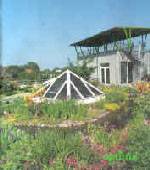|


Related Topics

| |
Table of Contents
 Introduction Introduction
 Soil
Preparation Soil
Preparation
 Plant
Selection Plant
Selection
 Cultural
Practices Cultural
Practices
 Alternatives Alternatives
Introduction
Home gardeners often use more pesticides per square foot in their
gardens than farmers do in the fields, thinking that if a little is good, more
will be better. This is a serious mistake, and a misuse of pesticides. Over-use
of pesticides has a number of adverse effects: it makes your food less safe to
eat, especially if there are residues at harvest time; it makes handling the
plants more dangerous; beneficial insects, earthworms, birds, even pets may be
harmed or killed along with the "bad guys;" each time the gardener
sprays, she or he is exposed to the dangers of inhalation or absorption of the
toxin; pesticides used near water may contaminate the water supply; continuous
use of certain pesticides may induce resistance in the pests, thus requiring the
gardener to switch to more toxic substances; some pesticides do not break down
easily and can remain in the environment for years.
The growing public concern over the use and misuse of
pesticides has led increasing numbers of home gardeners to seek means of
"natural" pest control. Although some people do not have the time or
knowledge to practice all the available alternative methods for controlling
pests, there are many cultural practices which will help reduce losses. Because
the gardener does not have to live up to perfect market standards, pesticide use
may be reduced to a minimum with a little research and effort. And, if the
choice is between minor insect damage and a possible pesticide residue, consider
accepting the visible blemish you can cut out.
Return to Table of Contents
Soil Preparation
-
Maintain a slightly acid soil (around pH 6.5). If in doubt,
have an analysis done of your soil through your local Extension Office, by a
private lab, or with a soil test kit. The appropriate pH allows vegetable
plants to have access to all the necessary soil nutrients and provides a
suitable environment for earthworms and microorganisms.
-
Build a biologically active, healthy soil through regular
addition of organic matter. Compost and manure can be incorporated into the
soil and various mulches such as leaves and grass clippings can be applied
on the surface. Organic matter is essential for providing good soil
structure, moisture infiltration and retention, and gradual release of plant
nutrients. Regular addition of organic matter to garden soil can totally
eliminate the need for chemical fertilizers, although moderate use of
chemical fertilizers is helpful during a transition period until sufficient
soil organic matter content has been obtained. Addition of organic matter
has also been shown to be effective in suppressing many soil-borne plant
pathogens by encouraging beneficial microorganisms. By improving the general
conditions for plant growth (i.e., moisture retention, improved soil
aeration, and soil fertility), the addition of organic matter helps reduce
various stresses on plants which make them susceptible to pathogens and
insect pests.
-
Grow winter annual cover crops to provide additional
organic matter without the effort of hauling, fix free nitrogen from the
air, reduce loss of soluble plant growth nutrients through leaching, and
provide a bright patch of greenery during the winter months. A mixture of
rye grain and hairy vetch makes a good winter annual cover crop if seeded at
a rate of 2 lbs rye and 1 lb of hairy vetch per 1,000 sq ft of garden. After
the summer garden crops have been harvested, stalks and vines should be
removed and composted, and the garden lightly tilled to prepare a seedbed.
The cover crop seed can be broadcast and raked lightly with a leaf rake to
cover the seed. If possible, irrigate after planting and then every 4-7 days
until the crop has emerged. Be sure to inoculate the hairy vetch seed with
Rhizobium bacteria to enable the vetch to fix nitrogen. Pour the seed into a
bucket with a small amount of vetch inoculant (available in garden stores)
and add enough water to dampen the seed. Mix thoroughly and plant. Winter
annual cover crops can be planted as late as Oct. 15-25. In the spring, mow
the cover crop with a lawn mower set at the highest setting prior to
tilling. Till in the cover crop at least two weeks prior to planting garden
crops. During spring and summer, as areas of the garden are harvested, plant
a summer cover crop of buckwheat. This crop grows quickly, maturing in less
than thirty days. Let the buckwheat flower, but incorporate prior to seed
set.
-
When diseased plant material is added to compost to be used
on your garden, delay using the compost until all has decayed beyond
recognition. Compost piles should be hot (140 degrees F.) to kill disease
organisms, insect eggs, and weed seeds.
-
Till in the fall to expose those stages of pests which live
near the surface of the soil to natural enemies and weather, and to destroy
insects in crop residues. Plant winter annual cover crops whenever possible.
-
If you do not till in the fall, do so early enough in the
spring to give remaining vegetation time to degrade before planting time.
Return to Table of Contents
Plant Selection
-
Plant crops that are suited to the soil and climate. If you
do plant vegetables or fruits that are not normally grown in your area, do
your best to provide necessary conditions. For example, watermelon prefers a
light, warm, well-drained soil; don't try to plant in heavy clay without
first adding copious amounts of compost or other soil-lightening material,
and allow the soil to warm up before seeding or setting plants out.
-
Use disease-free, certified seed, if available.
-
Select disease-resistant vegetable and fruit varieties.
-
Select plants that are sturdy and have well-developed root
systems. Diseases and insects in young seedlings may start in greenhouses or
plant beds and cause heavy losses in the garden. Buy plants from a reputable
grower who can assure you that they are disease- and insect-free, or grow
your own from seed.
Return to Table of Contents
Cultural Practices
-
The most effective and most important of all practices is
to observe what is going on in the garden! Many serious disease or insect
problems can be halted or slowed down early by the gardener who knows what
to look for and regularly visits the garden for the purpose of
trouble-shooting.
-
Water in the morning so that plants have time to dry before
the cool evening. Drip irrigation prevents foliage from getting wet at all
when watering. For plants susceptible to fungus infections, such as late
blight on tomatoes, leave extra space between them to allow good air flow;
orient rows so that prevailing winds will help foliage dry quickly after a
rain or watering. While this may reduce the number of plants per square
foot, you may still get higher yields because of reduced disease problems.
-
Use interplantings as opposed to solid plantings of a crop.
This can slow the spread of diseases and pests, giving you more time to deal
with them.
-
Thin young plants to a proper stand. Overcrowding causes
weak growth and subsequent insect and disease problems.
-
Keep down weeds and grass. They often harbor pests and
compete for nutrients and water. Leaf mulches are extremely effective for
weed control.
-
Use a mulch to reduce soil splash, which brings soil-borne
diseases into contact with lower leaves.
-
Rotate your garden plot, if you can. Do not grow the same
kind of produce in the same place each year. Use related crops in one site
only once every three or four years. Some related crops are as follows: (a)
chives, garlic, leeks, onions, shallots; (b) beets, Swiss chard, spinach;
(c) cabbage, cauliflower, kale, collards, Brussels sprouts, broccoli,
kohlrabi, turnips, rutabagas, Chinese cabbage, mustard; (d) peas, broad
beans, snap beans, lima beans; (e) carrots, parsley, celery, celeriac,
parsnips; (f) potatoes, eggplant, tomatoes, peppers; (g) pumpkins, squash,
watermelons, cucumbers, muskmelons; and (h) endive, salsify, lettuce.
-
Avoid injury to vegetable plants. Cuts, bruises, cracks and
insect damage are often the site for infection by disease-causing organisms.
In cases where fruits are difficult to remove (such as cucumbers and
watermelons), cut them off instead of pulling them off the plant. If you
cultivate your garden, avoid cutting into the plant roots.
-
Stay out of the garden when the plants are wet with rain or
dew to prevent spreading diseases.
-
Do not use tobacco products such as cigarettes or cigars
when working in the garden. Tomatoes, pepper, and eggplant are susceptible
to a mosaic virus disease common in tobacco and may be spread by your hands.
-
Remove infected leaves from diseased plants as soon as you
observe them. Dispose of severely diseased plants before they contaminate
others.
-
Clean up crop refuse as soon as you are finished harvesting
if possible.
-
Keep old sacks, baskets, decaying vegetables, and other
rubbish which may harbor insects and diseases out of the garden.
-
Staking plants or planting them in wire cages prevents the
fruit from coming in contact with the soil. This also helps prevent fruit
rots. Caging helps reduce sun scald often seen in staked tomatoes, since
caged plants do not require as much pruning, leaving a heavier foliage
cover. Place boards or a light, open mulch such as straw beneath melons
lying on the ground to prevent rotting.
-
Time plantings in such a way that the majority of your crop
will avoid the peak of insect infestations. For example, plant squash as
early as possible to avoid borers, which lay eggs in July. Keep a record of
the dates insect problems occur. Also, by planting warm-weather crops after
the soil has warmed, you will avoid problems with seed and root rots; growth
will be more vigorous, as well.
-
Inspect plants for egg clusters, bean beetles, and
caterpillars and other insects as often as possible. Hand-pick as many as
you can. Knocking insects and egg clusters into a coffee can with a small
amount of water in it and then pouring boiling water over them is a way to
kill insects if you don't like squashing them. Kerosene is often
recommended, but there is a disposal problem once you have finished;
besides, water is cheaper.
Return to Table of Contents
Alternatives
-
Take advantage of the biological control already taking
place in your garden by encouraging natural predators, such as preying
mantises, ladybugs, lacewings, ground beetles, and others. Purchased natural
predators are often ineffective, however, since they tend not to remain in
the place where they are put. Research the likes and dislikes of these
helpers as to foods, habitat, etc. Provide these conditions where possible.
Learn to recognize the eggs and larvae of the beneficial insects and avoid
harming them. For example, the tomato hornworm is often seen with a number
of white egg cases, a little larger than a grain of rice, on its back. These
were laid by a parasitic wasp. The hornworm will die and more wasps will
emerge. Obviously, it is to your advantage to leave the worm in the garden,
moving it to another place if it is doing a lot of damage. Spiders, toads,
and dragonflies are beneficial and should not be a source of fright to the
gardener; in most cases they are harmless to people.
-
Use various insect traps to reduce the insect population
levels. Upturned flower pots, bamboo lengths, boards, etc. will trap earwigs
and sowbugs; collect them every morning and feed to pet frogs, toads,
turtles, and fish, or destroy with boiling water. Slugs can also be caught
by these means and can be killed. Indoors, white flies can be caught with
sticky yellow traps, made with boards painted yellow and lightly coated with
oil or grease. There are also commercial sticky traps available through some
catalogs. Although several Japanese beetle traps are on the market which are
effective at attracting beetles, use of these traps has not been shown to be
effective in preventing Japanese beetle injury to garden plants, since the
traps attract beetles from a wide area. Similarly, light traps and electric
"zapper" traps operated at night can capture or kill a large
number of insects; however, these devices are indiscriminant -- they kill
beneficial as well as pest insects -- and will not aid in control of insect
pests.
-
Natural pesticidal products are available as an alternative
to synthetic chemical formulations. Some of the botanical pesticides are
fairly toxic to fish and other cold-blooded creatures and should be treated
with care. Safety clothing should be worn when spraying these even though
their toxicity is low to warm-blooded animals. The botanical insecticides
break down readily in soil and are not stored in plant or animal tissue.
Often their effects are not as long-lasting as those of synthetic
pesticides. Apply insecticides locally, to take care of a specific pest
problem, instead of blanketing the entire garden.
|
INSECTICIDE |
USE AGAINST |
|
Pyrethrum |
Pickleworms, aphids, leafhoppers, spider mites,
harlequin bugs, cabbageworms, Mexican bean beetles, flea beetles, flies,
squash bugs |
|
|
|
Rotenone |
Colorado potato beetle, Mexican bean beetle, Japanese
beetle, flea beetles, cucumber beetles, spittlebugs, aphids, potato
beetles, mites, carpenter ants, cabbage worms, loopers, fleas |
|
Ryania |
Codling moths, corn earworm, Oriental fruit moth,
potato aphids, onion, thrips, corn earworms, |
|
Sabadilla |
Armyworms, Harlequin bugs, stink bugs, cucumber
beetles, leafhoppers, cabbage loopers, blister beetles |
Some of these products may be very difficult to find.
-
In addition to the botanical insecticides, some biological
products can help in the battle against insects. Bacillus thuringiensis is
an effective product commonly used against moth larvae. B.t., as it is
known, is a bacteria that produces a toxin quite lethal to caterpillars, but
nontoxic to beneficial insects and mammals. B.t. is most effective on young
larvae. Presently, there is research underway to develop strains that work
against other types of insect larvae. Another biocontrol product which is
just becoming available to gardeners is grasshopper spore; it is not proven
for small-scale use, but may help gardeners reduce damage by grasshoppers.
-
Commercial insecticidal soap, a special formulation of
fatty acids, has been proven effective against aphids, leafhoppers,
mealybugs, mites, pear psylla, thrips, and whiteflies. Homemade soap sprays
also work to some extent: use three tablespoons of soap flakes (not
detergent) per gallon of water and spray on plants till dripping. Repellent
sprays, such as garlic sprays and bug sprays (made from a puree of bugs),
have been found useful by some gardeners, but their effectiveness is
questionable. Some researchers believe that bug sprays may work if a disease
is present in the insect, which is spread through the spray to other
insects.
-
Various materials can be used to physically block or repel
insects and keep them from damaging the plants. Place wood ash, cardboard
tubes, or orange juice cans around seedlings to keep cutworms away from
plant stems. Use paper bags over ears of corn to keep birds and insects out;
do not cover until pollination is complete. Net-covered cages over young
seedlings will help prevent insect, bird, and rabbit damage.
-
Where slugs are a problem, use methods described under
trapping above, and try to create drier conditions. Heavy mulches may
sometimes encourage slugs. Spread crushed eggshells or hydrated lime around
affected plants.
-
Enlist the aid of birds in your garden. In rural areas,
chickens, guineas, and other domestic fowl are released in unused areas of
the garden to eat grubs and insects. Wild birds will also help, but aren't
as controllable. If you encourage wild birds you will have to protect
ripening fruit (and even some vegetables); use bird netting or scare devices
(aluminum pans banging in the breeze are fairly effective). Overall, birds
do more good than harm. Consider planting shrubs and trees with fruits that
attract them.
Return to Table of Contents
|
![]() Gardeners' Corner
Kids'
Garden
Sustainable Garden
Contact Us
Gardeners' Corner
Kids'
Garden
Sustainable Garden
Contact Us![]()


